Physical Address
304 North Cardinal St.
Dorchester Center, MA 02124
Free tissue transfer offers a well-accepted, superior ability to restore form and function to certain major defects of the head and neck. Microvascular surgery provides distinct advantages for reconstruction of osseous defects of the mandible, large glossectomy defects, total or near-total pharyngeal defects, and complex defects of the midface and skull base. Theoretically, any tissue with a defined vascular circuit (i.e., perforator) can be transferred as a free flap, but for reconstruction of defects in the head and neck, there are six free flaps which are particularly useful: the radial forearm free flap (RFFF), the anterolateral thigh (ALT) flap, parascapular and scapular free flaps, rectus abdominis and deep inferior epigastric perforator (DIEP) flap, fibula free flap (FFF), and jejunal free flaps.
When possible, resected tissue should be reconstructed with tissue that duplicates both the appearance and the function of the resected tissue. Epithelium can be used to resurface mucosal or skin defects. Muscle can be used to restore bulk and motion, and palatal and mandibular skeletal defects can be reconstructed with bone.
The ALT free flap, the flap most commonly used for reconstruction of defects in the head and neck, is routinely designed from perforators from the descending branch of the lateral circumflex artery/vein.
Multiple options (i.e., medial thigh free flap, tensor fascia lata free flap) from the thigh are available for soft tissue reconstruction, in addition or instead of an ALT free flap.
The fibula will provide up to 26 cm of bone vascularized by the peroneal artery and its two venae comitantes.
History of present illness
Successful reconstruction begins with planning the extirpation of the tumor based on Tumor Node Metastasis (TNM) stage and anticipating the impact of both the extirpation and reconstruction on the patient’s quality of life.
Prognosis, dental rehabilitation goals, the need for postoperative radiation therapy, and the type of neck dissection may impact surgical choices (i.e., recipient vessels, type of free flap).
Past medical history
Cardiac, vascular, and pulmonary disease, as well as alcoholism, are common in patients with cancer of the head and neck and may independently impact survival and limit reconstructive options.
Radiation induces soft tissue fibrosis, in particular perivascular fibrosis. Therefore, a history of prior radiation and the anticipated decreased vascularity may guide reconstructive options toward using a pedicled or free flap instead of a skin graft.
Previous surgery, such as open abdominal surgery or open reduction and internal fixation of a radius fracture or a tibial fracture, may limit the choice of an extremity or of the abdomen as a donor site.
An Allen test should be performed prior to harvesting an RFFF to ensure the postoperative viability of the hand.
Determine whether a patient has a pre-existing hernia of the abdominal wall before harvesting a rectus abdominis, iliac crest free flap, or jejunal free flap.
Confirm the presence of a palpable dorsalis pedis and posterior tibialis pulse prior to harvesting a fibular free flap.
Palpate the thickness of the thigh to determine its suitability for tissue transfer as an ALT flap.
Preoperative imaging with a computed tomography (CT) scan and/or magnetic resonance imaging (MRI) to determine the extent of the tumor
Pre-bent plates and CT-guided templates can be fabricated prior to surgery to assist in designing and insetting osseous flaps.
The need for preoperative vascular assessment prior to fibular transfer is controversial. Large series done without preoperative imaging have reported no adverse sequelae, yet given the prevalence of the risk factors for peripheral vascular disease in the cancer of the head and neck population, others have stressed the need for vascular evaluation. Ankle-arm index screening and color flow Doppler imaging may be more economical and efficient ways to evaluate the vasculature of the lower extremity than angiography or magnetic resonance angiography.
Mandibular defects
The morbidity of mandibular resection upon function is highly variable. The level of postoperative disability depends on (1) the preoperative condition of the oral cavity (including the presence or absence of viable teeth), (2) the extent of mandible to be included in the resection, (3) the site of the tumor (anterior vs. lateral), and (4) the soft tissues to be resected.
When the mandible is resected with an accompanying large amount of soft tissue, the mandibular defect is sometimes “incidental” to the rest of the wound. Closure of the soft tissue defect with restoration of function and coverage of the planned mandibular reconstruction become the primary goals.
Some patients following a segmental lateral mandibulectomy function well without restoration of mandibular continuity. However, a contour deformity of the lower third of the face will develop in patients who have not been reconstructed, and the pull of the contralateral muscles of mastication displaces the remaining mandible toward the side of the defect. In patients with dentition, this results in malocclusion. For these reasons, most surgeons offer patients primary reconstruction of lateral mandible defects with an osseous free flap (i.e., FFF or osteocutaneous RFFF; Fig. 162.1 ).
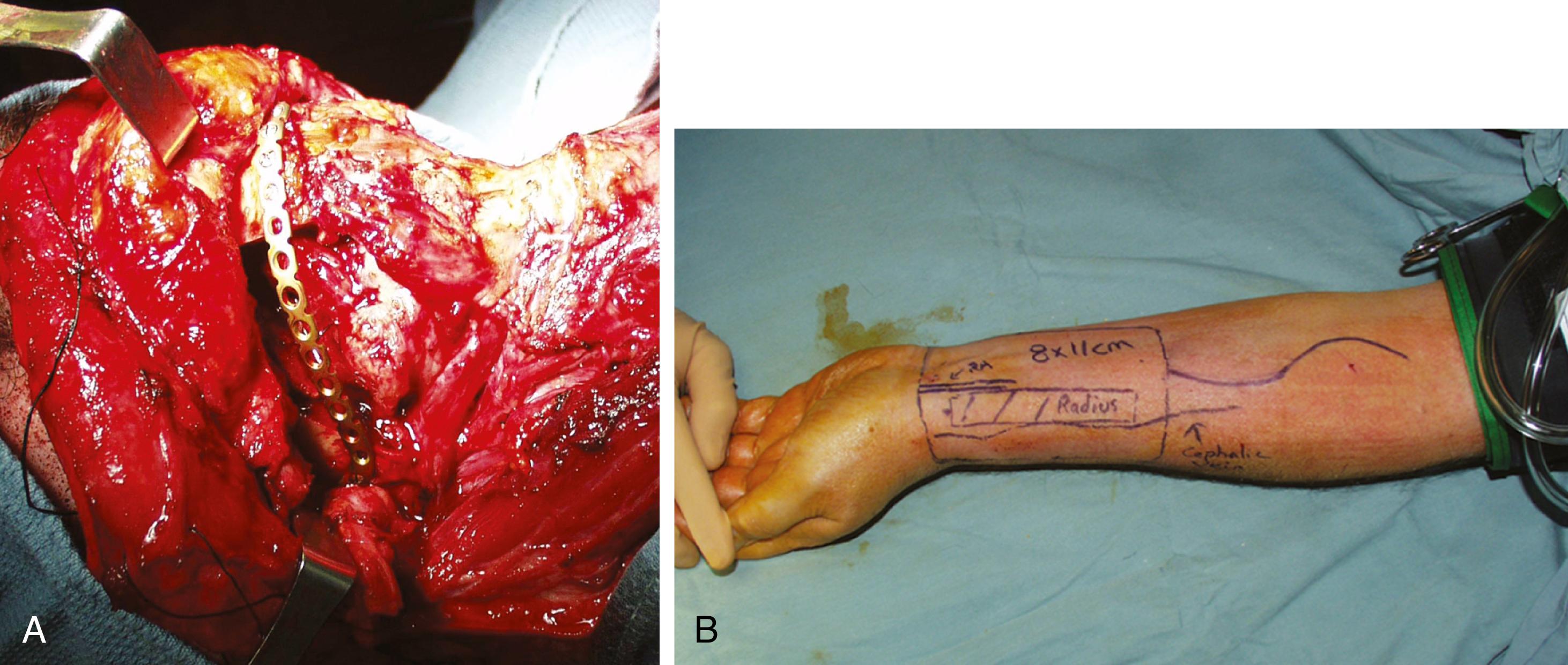
Numerous reports have supported the use of a reconstruction plate with soft tissue coverage to reconstruct pure lateral mandibular defects ( Fig. 162.2 ). Soft tissue coverage has been generally provided by a pectoralis myocutaneous flap or a soft tissue free flap.
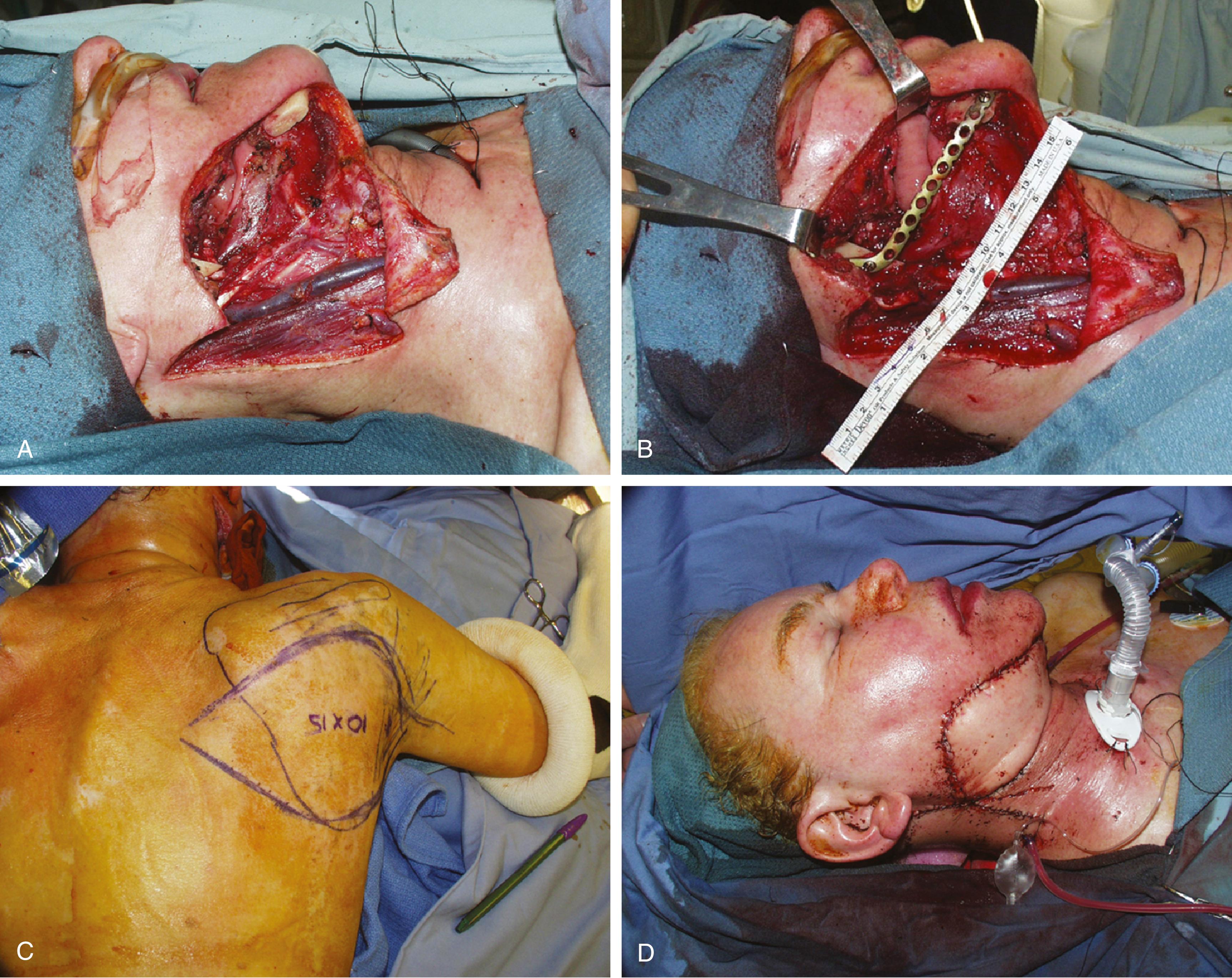
Delayed reconstructive failure secondary to external plate exposure or plate fracture has been generally reported to be between 7% and 30%, with soft tissue coverage provided only with a pectoralis flap. These rates of failure would likely be much higher if patients survived longer than 3 years. (Three-year survival of patients selected for reconstruction with a pectoralis flap is 11%.)
Resection of the anterior mandible can leave a patient an oral cripple. When reconstruction is not attempted, the retained segments of the mandible tend to collapse toward the midline. This lack of support results in the Andy Gump deformity, with the associated oral incontinence and cosmetic deformity.
Free tissue transfer of a composite, osteocutaneous flap is the reconstructive method of choice for anterior defects ( Fig. 162.3 ).
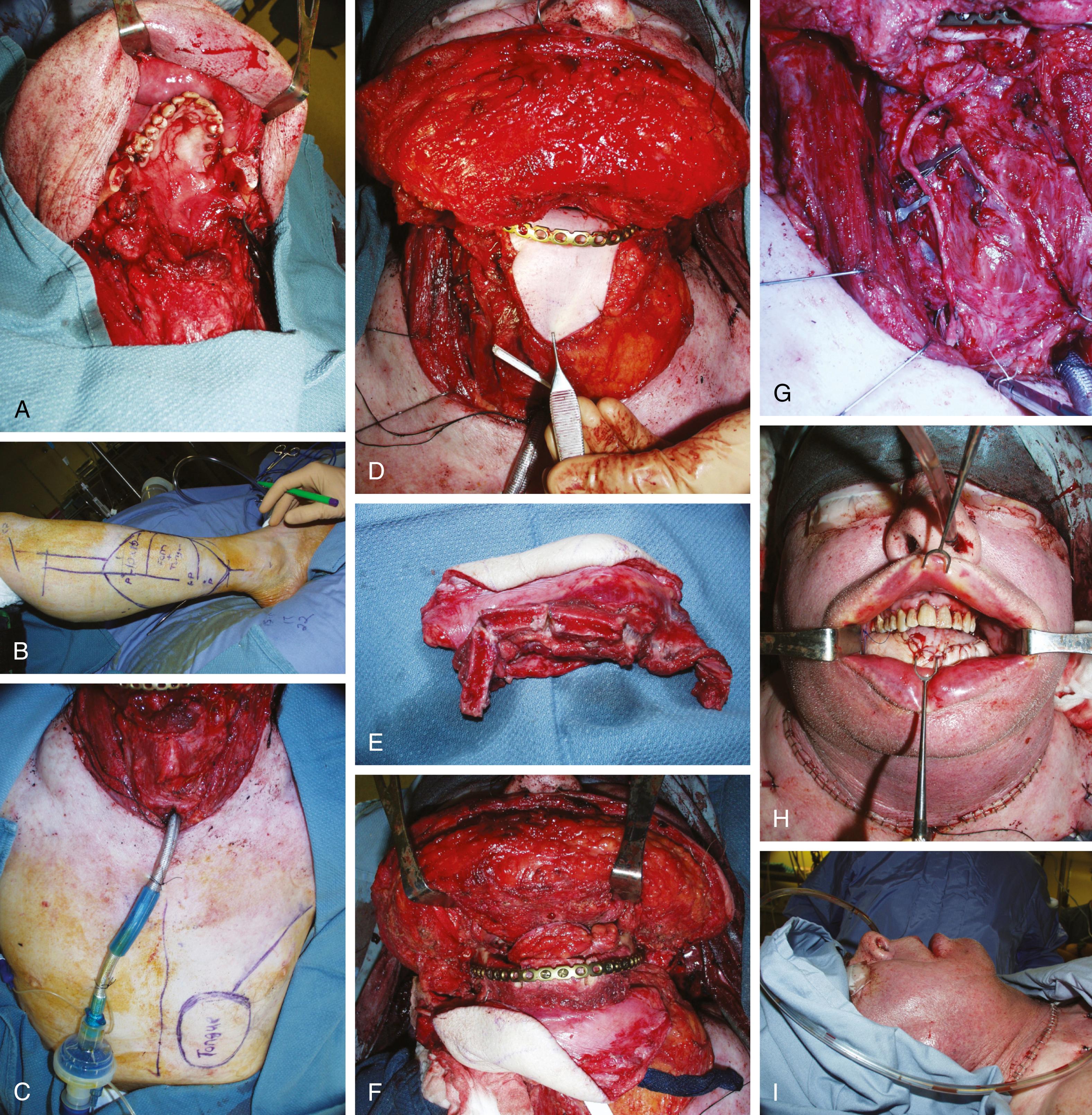
Glossectomy defects
It is unrealistic to expect a unidirectional, reinnervated muscle, such as the rectus abdominis, to mimic the complex, pattern of muscle contraction in the native tongue.
The attainable goals of tongue reconstruction are to preserve the mobility of the remaining tongue and to restore bulk so that the neotongue can contact with the palate to assist in articulation and swallowing.
Because of the different functions of the two regions, the tongue is divided into the mobile anterior part and the base of the tongue. The mobility of the anterior tongue is critical for articulation, mastication, and the oral phase of swallowing. The base of the tongue is critical in completing the pharyngeal phase of swallowing.
The approach to reconstructing the mobile tongue should involve the use of thin, sensate, pliable tissues (i.e., RFFF or ALT free flap) that maintain maximum mobility and potentially restore sensation.
Defects of the base of the tongue present a separate problem. Volume of the base of the tongue must be restored so that the base of the tongue can contact the pharyngeal walls and generate a force to drive the food bolus through the pharynx.
Two flaps, in particular an ALT (or a RFFF, rectus abdominis free flap, or pectoralis flap) with a fibular flap, may be necessary for complex composite defects involving a segmental mandibulectomy defect with a glossectomy defect.
Pharyngectomy defect
The major goal of pharyngeal reconstruction is the restoration of swallowing. It is important to choose a flap that is not too bulky in order to avoid obstruction.
ALT ( Fig. 162.4 ), RFF ( Fig. 162.5 ), and jejunal free flaps are the primary options for pharyngeal reconstruction.
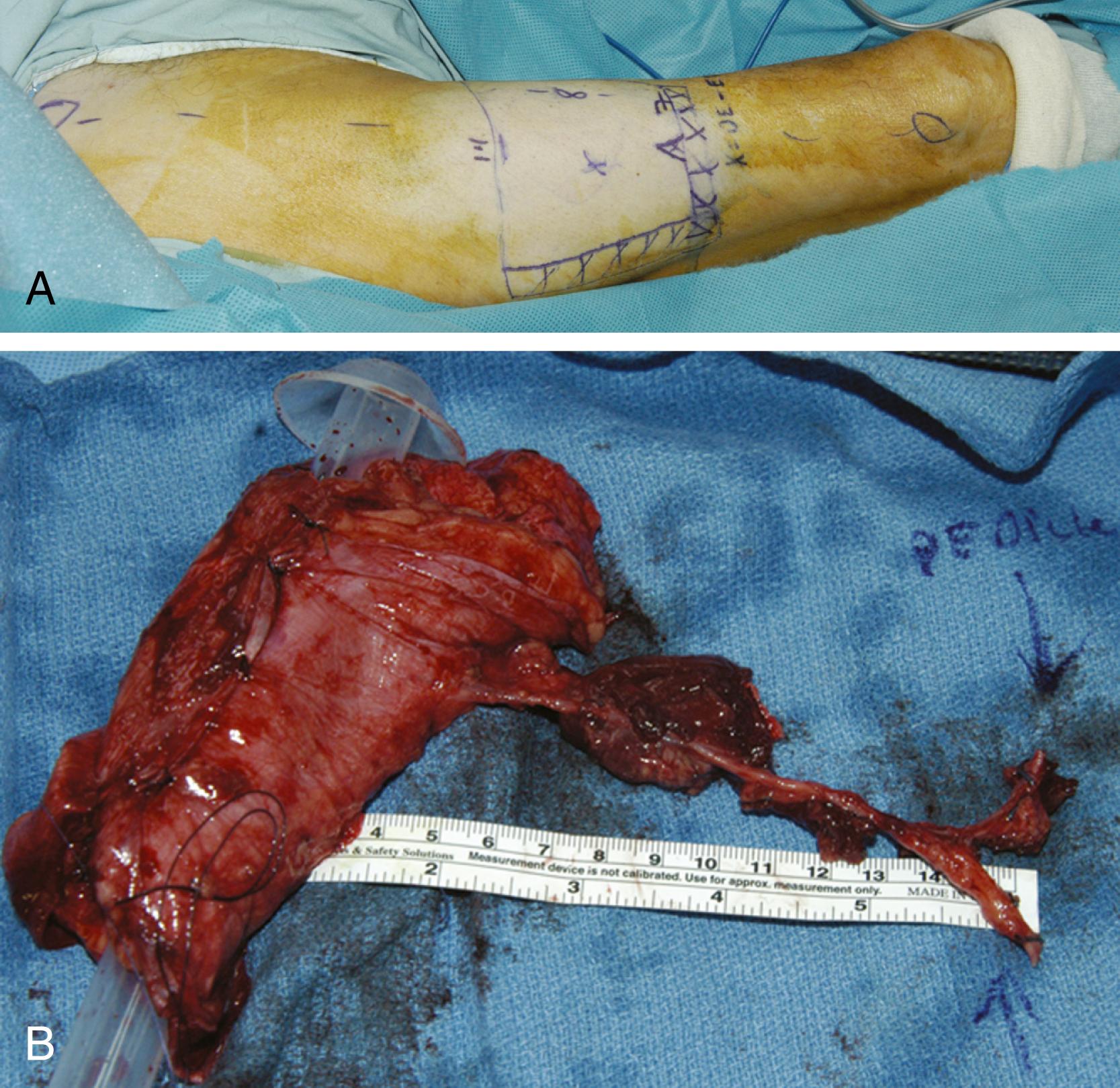
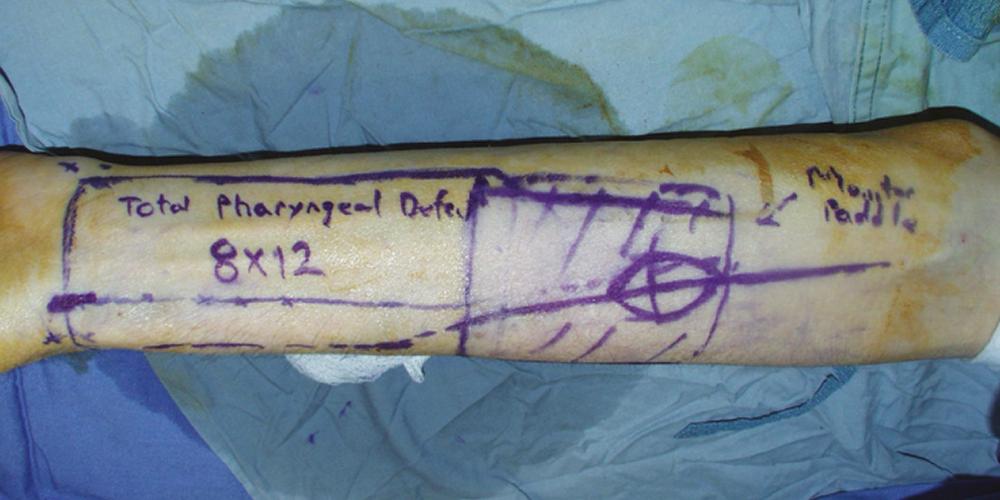
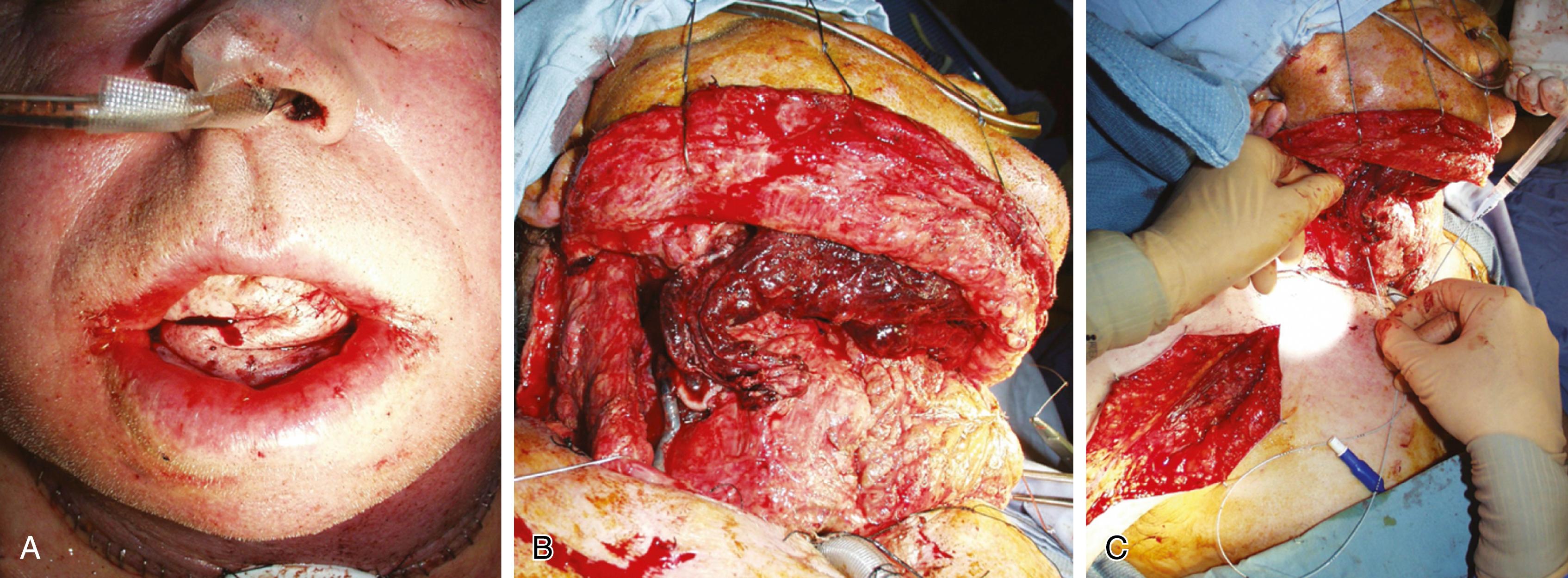
Laryngeal preservation in the setting of a major pharyngeal defect is especially challenging because aspiration is inevitable. In addition to the patient’s preoperative function, designing a reconstruction that can minimize aspiration may be the critical issue that determines whether a patient will require a laryngectomy.
In most cases of advanced laryngopharyngeal or pharyngeal cancer, the larynx is resected.
If the cervical esophageal resection extends below the thoracic inlet, gastric pull-up continues to be the most reliable way to avoid a salivary leak in the chest.
Midface and maxillectomy defects
Defects in the midface occur after resection of tumors that arise from the paranasal sinuses, palate, overlying skin, nasal cavity, skull base, orbital contents, or oral mucosa. As a result, extensive reconstruction of the midface may require independently reconstructing the palate, orbit, cheek, and bony midface (maxilla and zygoma).
Cordeiro and Santamaria proposed a classification system and algorithm for reconstruction of maxillectomy and midfacial structures. The temporalis muscle, soft tissue free flaps (rectus abdominis and radial forearm), nonvascularized bone (rib or calvarium), and vascularized bone flaps (osteocutaneous RFFF) were used to construct a variety of maxillectomy defects. Palatal defects were closed only with soft tissue. The nonvascularized and vascularized bone were used for the osseous reconstruction of the zygoma, maxilla, and orbital floor.
The use of an FFF for midface reconstruction allows for the osteointegration of implants for dental rehabilitation.
The ALT can be designed with multiple skin paddles, based on separate perforators, to reconstruct many midface/maxillectomy defects.
In cases of combined midface and lip resection, oral competency can be restored by using local flaps, such as the Abbe lip-switch flap, in combination with free tissue transfer.
Skull base defects
Although small defects can and should be reconstructed with local flaps, such as pericranial or temporoparietal fascial flaps, many defects in the expanding spectrum of extirpative endeavors will require free tissue transfer.
The main reconstructive needs of skull base defects include separating the intracranial and extracranial spaces to avoid intracranial infections, obliterating the dead space with coverage of vital structures, preventing brain herniation, diminishing the risk of cerebrospinal fluid (CSF) leakage, and restoring cosmesis.
The rectus abdominis, ALT, latissimus myocutaneous (or myofascial), and serratus free flaps are some of the flaps commonly chosen.
An expectation of a poor quality of life or of limited survival, regardless of the ability to successfully extirpate the tumor, may change the reconstructive recommendation.
Severe peripheral vascular disease and lack of recipient vessels in the neck following previous surgery may make the harvest and anastomosis of a free flap impossible.
Plan for the possible need for a second or backup free or pedicled flap. Protect an extremity so that no venipuncture is done in this extremity.
Be sure the tumor margins are clear before finalizing flap design.
Determine the recipient cervical vessels likely for anastomosis. If the neck is without recipient vessels, prepare for the possibility of vein grafts from the extremities.
Become a Clinical Tree membership for Full access and enjoy Unlimited articles
If you are a member. Log in here